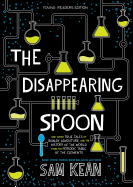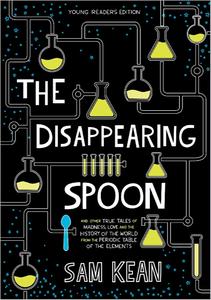
 A "treasure trove of all our passions and obsessions," the periodic table of the elements is more than a turreted catalogue of the different kinds of matter in the universe. "The periodic table is... an anthropologic marvel, a human artifact that reflects all of the wonderful and artful and ugly aspects of human beings and how we interact with the physical world--the history of our species written in a compact and elegant script." In the young readers edition of his bestselling The Disappearing Spoon, science writer Sam Kean (Caesar's Last Breath; The Violinist's Thumb) presents the wide-ranging history, conflict, rumors and science behind each element, from discovery to present-day use.
A "treasure trove of all our passions and obsessions," the periodic table of the elements is more than a turreted catalogue of the different kinds of matter in the universe. "The periodic table is... an anthropologic marvel, a human artifact that reflects all of the wonderful and artful and ugly aspects of human beings and how we interact with the physical world--the history of our species written in a compact and elegant script." In the young readers edition of his bestselling The Disappearing Spoon, science writer Sam Kean (Caesar's Last Breath; The Violinist's Thumb) presents the wide-ranging history, conflict, rumors and science behind each element, from discovery to present-day use.
Kean tells of bitter custody battles over element discoveries; fierce competition among nations and individual scientists to claim naming rights; and sometimes humorous, often insanely dangerous exploits in the name of science or power or greed. During the 1990s, for example, a 16-year-old Boy Scout decided to try to solve the world's energy crisis by building a nuclear reactor in his backyard shed, gathering radioactive elements from wholesalers and cut-open batteries. Further back, in the sixth century BC, after a Babylonian king had his palace walls painted yellow with an antimony-lead paint mixture, he went mad. Antimony, or element 51, needless to say, is highly toxic. In another Poe-worthy tale, a plot was hatched (but never carried out) by the CIA to assassinate Fidel Castro by sprinkling his socks with a talcum powder laced with thallium (element 81), also known as the "poisoner's poison." And, yes, it is possible to make a spoon disappear in your cup of tea, as long as that spoon is made of the easily meltable element 31, gallium.
The Disappearing Spoon, like the periodic table of elements, is laid out in a careful, systematic way. Five sections are divided into several chapters each, and Kean includes a glossary and the periodic table itself, which readers will flip back to again and again as they work their way through the building blocks of matter. Line drawings and sidebars illustrate and elucidate the material, while entertaining tidbits threaded through the narrative make The Disappearing Spoon more accessible for nonscientists who might otherwise be overwhelmed by the serious science within.
The Disappearing Spoon reveals how gloriously and dangerously intertwined everything truly is, and not just chemically speaking. Kean wraps his exploration of elements in history, politics, mythology, biology, etymology, medicine, warmongering, philosophy and more. He writes, "I realized that there's a funny, or odd, or chilling tale attached to every element on the periodic table. At the same time, the table is one of the great intellectual achievements of humankind. It's both a scientific accomplishment and a storybook...." This "storybook" will encourage young readers to brave the elements of science. --Emilie Coulter, freelance writer and editor
Shelf Talker: With wit and scientific savvy, Sam Kean tells the stories behind each of the elements in the periodic table in this middle-grade adaptation of The Disappearing Spoon.

